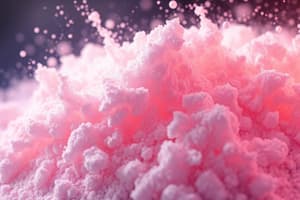Podcast
Questions and Answers
What does the diversity of life forms imply about their ancestral relations?
What does the diversity of life forms imply about their ancestral relations?
- All organisms have completely different biochemical processes.
- Diversity means that life forms have no common features.
- There is a shared ancestry among fundamentally related organisms. (correct)
- Organisms evolved independently of each other.
Why is it challenging to make absolute generalizations about living organisms?
Why is it challenging to make absolute generalizations about living organisms?
- The range of habitats and conditions results in vast diversity. (correct)
- Every organism behaves exactly the same under any condition.
- Living organisms are all the same due to shared ancestry.
- There are only a few species of living organisms.
What is a notable characteristic of biological reproduction mentioned in the content?
What is a notable characteristic of biological reproduction mentioned in the content?
- Reproduction often results in significant genetic mutations.
- Each organism is a unique individual with no similarity.
- Biological reproduction occurs with near-perfect fidelity. (correct)
- It occurs without any fidelity.
What does the ability of a single bacterial cell to produce billions of identical offspring in 24 hours illustrate?
What does the ability of a single bacterial cell to produce billions of identical offspring in 24 hours illustrate?
What is suggested by the term 'biochemical adaptations' mentioned in the context?
What is suggested by the term 'biochemical adaptations' mentioned in the context?
What can be inferred about the habitats where organisms are found based on the content?
What can be inferred about the habitats where organisms are found based on the content?
How does the concept of microscopic complexity relate to living organisms?
How does the concept of microscopic complexity relate to living organisms?
What shared feature is common to the diverse living organisms mentioned in the content?
What shared feature is common to the diverse living organisms mentioned in the content?
What is the primary purpose of creating a density gradient in isopycnic centrifugation?
What is the primary purpose of creating a density gradient in isopycnic centrifugation?
During isopycnic centrifugation, where is the solute, such as sucrose, primarily located in the centrifuge tube?
During isopycnic centrifugation, where is the solute, such as sucrose, primarily located in the centrifuge tube?
What happens to the organelles during the high-speed centrifugation in isopycnic centrifugation?
What happens to the organelles during the high-speed centrifugation in isopycnic centrifugation?
What characteristic of the density gradient allows for the separation of organelles?
What characteristic of the density gradient allows for the separation of organelles?
What is the result of layering a mixture of organelles on top of the density gradient?
What is the result of layering a mixture of organelles on top of the density gradient?
Which category of elements is needed in the diet in gram quantities daily?
Which category of elements is needed in the diet in gram quantities daily?
What is the primary requirement for trace elements in the human diet?
What is the primary requirement for trace elements in the human diet?
Which of the following elements is considered a trace element?
Which of the following elements is considered a trace element?
How do plants and microorganisms acquire their elemental requirements?
How do plants and microorganisms acquire their elemental requirements?
Which of the following elements is NOT a bulk element?
Which of the following elements is NOT a bulk element?
What is the characteristic feature of bulk elements?
What is the characteristic feature of bulk elements?
Which statement about trace elements is incorrect?
Which statement about trace elements is incorrect?
Which of the following elements is often categorized as essential for human biological processes?
Which of the following elements is often categorized as essential for human biological processes?
What is the primary role of the cytoskeleton in eukaryotic cells?
What is the primary role of the cytoskeleton in eukaryotic cells?
Which type of filament is involved in moving cytoplasmic organelles?
Which type of filament is involved in moving cytoplasmic organelles?
What happens to filaments during processes like mitosis and cytokinesis?
What happens to filaments during processes like mitosis and cytokinesis?
How do lysosomes, mitochondria, and chloroplasts differ in terms of enzymes?
How do lysosomes, mitochondria, and chloroplasts differ in terms of enzymes?
What regulates the assembly and disassembly of cytoplasmic filaments?
What regulates the assembly and disassembly of cytoplasmic filaments?
What is the width range of actin filaments?
What is the width range of actin filaments?
Which of the following is NOT one of the three general types of cytoplasmic filaments?
Which of the following is NOT one of the three general types of cytoplasmic filaments?
What do motor proteins provide for the motion of organelles in the cytoplasm?
What do motor proteins provide for the motion of organelles in the cytoplasm?
What describes the organization of the cytoplasm in eukaryotic cells?
What describes the organization of the cytoplasm in eukaryotic cells?
What processes are highlighted in the content as being highly organized during a cell's life?
What processes are highlighted in the content as being highly organized during a cell's life?
Which statement accurately reflects the nature of interactions between the cytoskeleton and organelles?
Which statement accurately reflects the nature of interactions between the cytoskeleton and organelles?
How do macromolecules differ from their monomeric subunits in size, based on the content?
How do macromolecules differ from their monomeric subunits in size, based on the content?
Which of the following statements is true regarding the size of an alanine molecule and hemoglobin mentioned in the content?
Which of the following statements is true regarding the size of an alanine molecule and hemoglobin mentioned in the content?
Flashcards are hidden until you start studying
Study Notes
Bulk and Trace Elements
- Bulk elements are essential structural components of cells and tissues, required in daily dietary quantities measured in grams.
- Key bulk elements include Sodium (Na), Magnesium (Mg), Aluminum (Al), Silicon (Si), Phosphorus (P), Sulfur (S), Chlorine (Cl), and Argon (Ar).
- Trace elements have much smaller daily requirements, typically measured in milligrams; essential trace elements for humans include Iron (Fe), Copper (Cu), and Zinc (Zn).
Elemental Requirements for Organisms
- Requirements for plants and microorganisms are similar to human needs, although acquisition methods may differ.
- Evolution has led to diverse life forms, which, despite superficial differences, share a common ancestry and fundamental properties.
Microscopic Complexity
- Microscopic structure of vertebrate muscle tissue showcases complex organization, observable through electron microscopy.
- Biological processes, including reproduction, exhibit high fidelity with self-replication capabilities in bacterial cells, allowing rapid population growth.
Cytoplasmic Organization and Dynamics
- Eukaryotic cells have a cytoskeleton comprising three types of protein filaments: actin filaments, microtubules, and intermediate filaments, differing in width, composition, and function.
- These filaments form a three-dimensional meshwork that is dynamic—capable of disassembly and reassembly, crucial for movement and structure within the cell.
Organelles and Protein Filaments
- Organelles are transported along protein filaments powered by motor proteins, allowing for regulated motion and organization within the cytoplasm.
- The endomembrane system facilitates vesicle movement between organelles, constantly changing in response to intracellular and extracellular signals.
Supramolecular Structures
- Macromolecules and their subunits vary greatly in size, from small amino acids to large proteins like hemoglobin, illustrating the complexity of cellular structures.
- Hemoglobin consists of nearly 600 amino acid subunits, thus underscoring the variety of molecular constructs necessary for biological function.
Studying That Suits You
Use AI to generate personalized quizzes and flashcards to suit your learning preferences.





